Table of Contents
- Introduction
- Editor’s Choice
- Global Biofuels Market Overview
- Biofuels Production Market Overview
- Biofuel Production Statistics
- Biofuel Consumption Statistics
- Biofuel Demand Statistics
- Biofuel Energy Production Statistics
- Potential Benefits of Biofuels
- Potential Side-effects of Biofuels
- Regulations, Laws, And Policies for Biofuels
Introduction
According to Biofuels Statistics, Biofuels are renewable energy sources derived from organic materials like plants and plant-derived materials.
They include ethanol, biodiesel, biogas, and bioethers, and each is produced through various processes such as fermentation, transesterification, or anaerobic digestion.
Biofuels offer benefits such as reduced greenhouse gas emissions, increased energy security, and potential economic development.
However, challenges like competition with food crops and concerns about land use change exist.
Advanced biofuels, derived from non-food biomass sources, offer promise for even greater environmental benefits and reduced competition with food production.
Editor’s Choice
- The global biofuels market is expected to reach a remarkable revenue of USD 276 billion by 2032.
- Biofuels Digest leads with an 18% market share, making it the dominant player in the industry.
- The global biofuel market is distributed across several regions. With North America leading the way with a substantial market share of 41.8%.
- In 2022, global biofuel production was led by the United States. Which produced 1,626.6 petajoules of biofuels, making it the top producer worldwide.
- Global biofuel consumption is projected to reach 213.7 billion liters by 2030.
- In terms of biofuel energy production, the United States leads globally with an impressive output of 451.83 terawatt-hours (TWh) per year.
- Ethanol from corn and cereals can reduce CO2 emissions by 15%-25% compared to gasoline.
- For 2023-2025, the U.S. Environmental Protection Agency (EPA) has established targets for various biofuels, including cellulosic biofuel and biomass-based diesel.
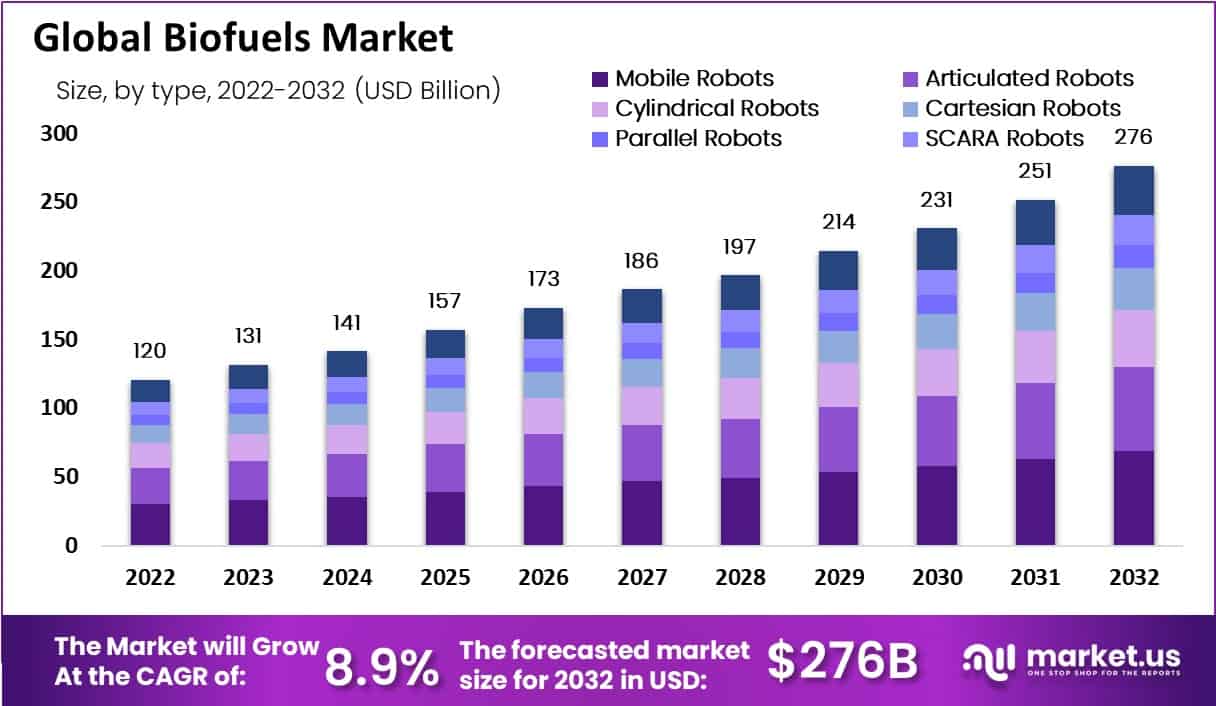
Global Biofuels Market Overview
Global Biofuels Market Size
- The global biofuels market has shown consistent growth from 2022 to 2032 at a CAGR of 8.90%, with significant increases in revenue each year.
- In 2022, the market revenue was recorded at USD 120 billion.
- By 2032, the global biofuels market reached a remarkable revenue of USD 276 billion. Underscoring the sector’s robust expansion over the decade.
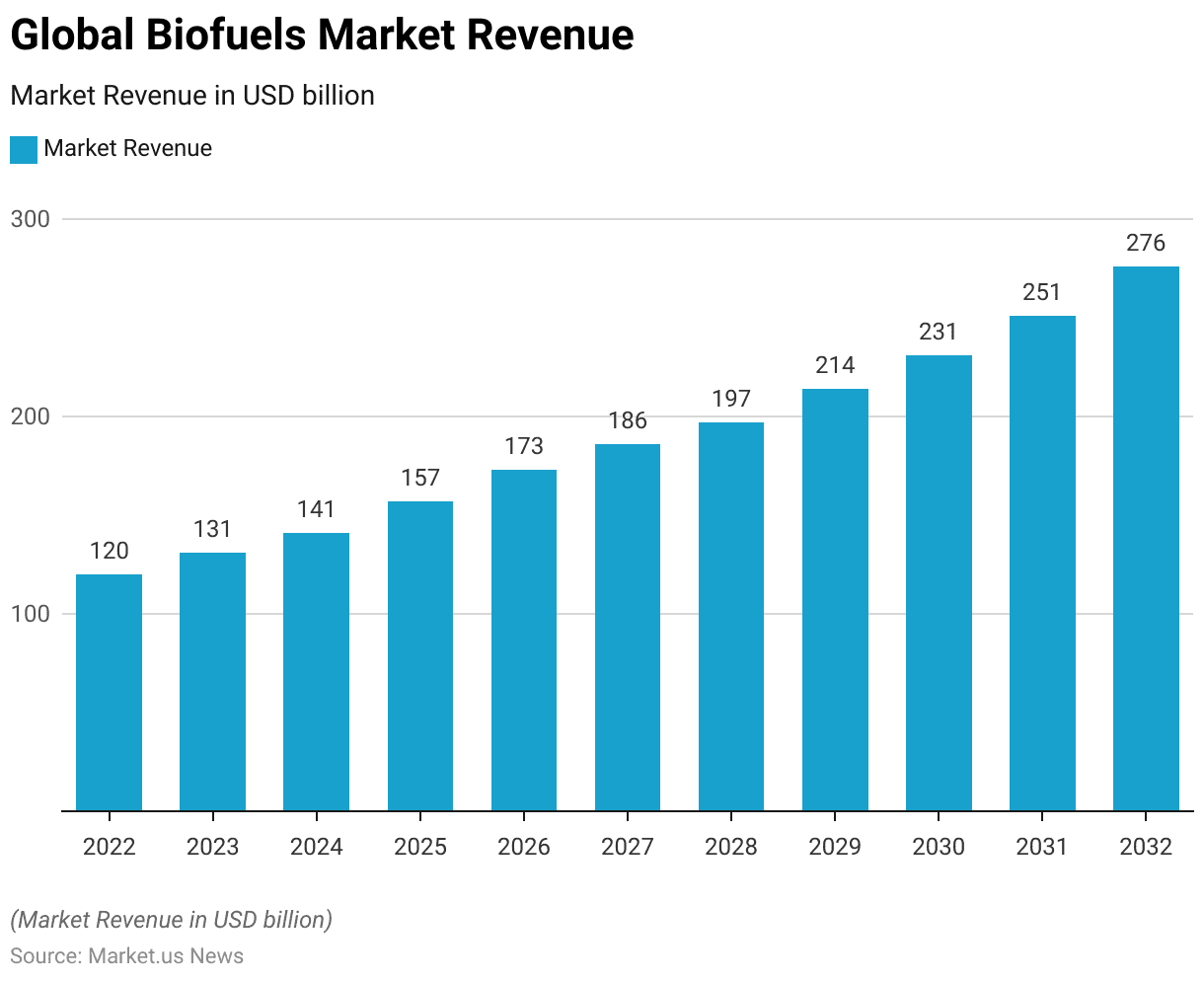
Competitive Landscape of Global Biofuels Market
- The presence of several key players characterizes the global biofuels market, each holding a significant share of the market.
- Biofuels Digest leads with an 18% market share, making it the dominant player in the industry.
- Infinita Biotech Private Limited and Gruppo Marseglia follow with market shares of 10% and 11%, respectively.
- Neste Nederland B.V., Louis Dreyfus Company, and Crop Energies AG each hold a 9% share, indicating their strong presence in the market.
- Chevron captures 8% of the market, while Glencore holds a 7% share.
- The remaining 14% of the market is comprised of various other key players. Collectively contributing to the diversity and competitiveness of the biofuels sector.
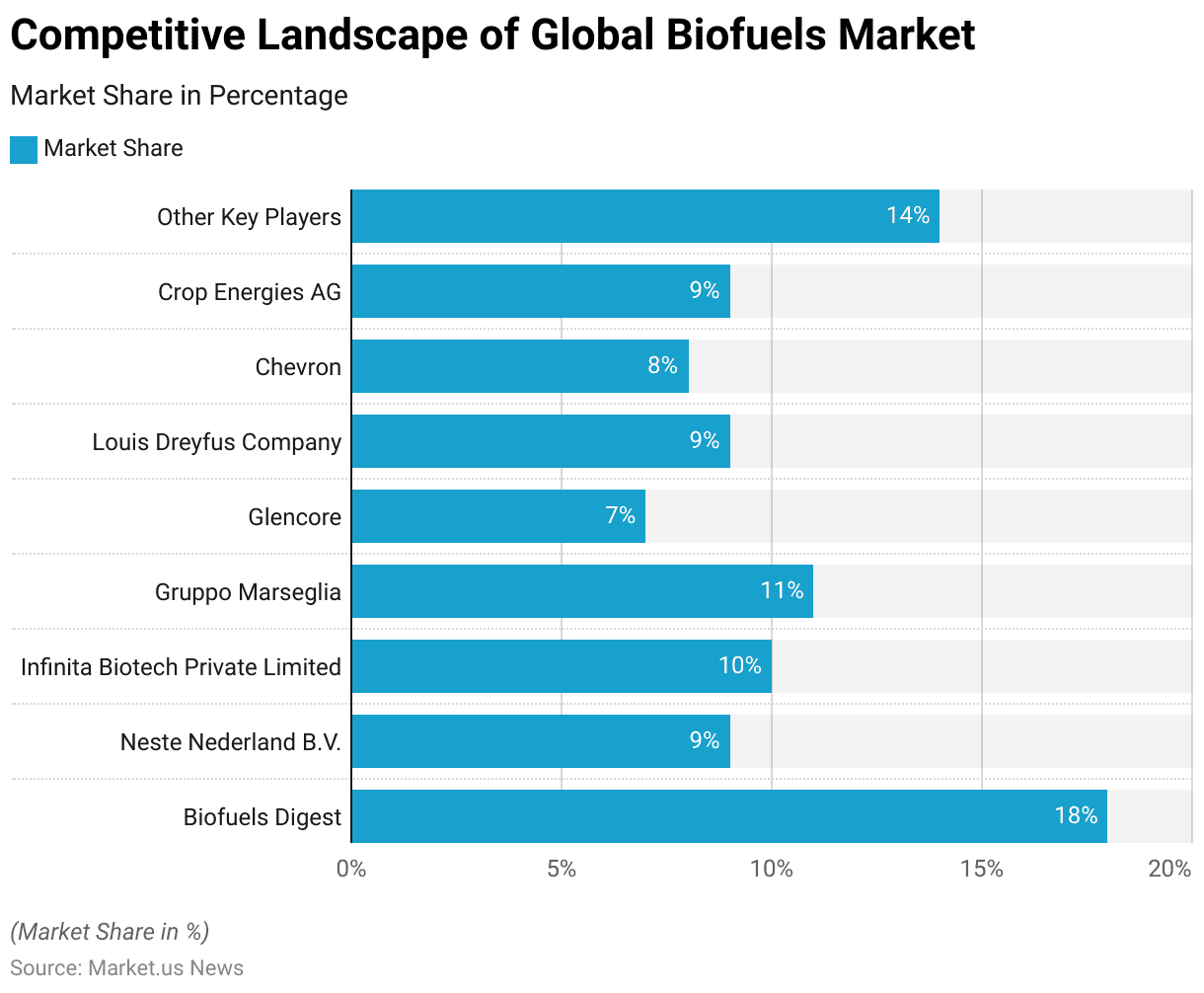
Regional Analysis of Global Biofuels Market
- The global biofuel market is distributed across several regions. With North America leading the way with a substantial market share of 41.8%.
- Europe follows, capturing 24.3% of the market, reflecting its strong focus on renewable energy initiatives.
- The Asia-Pacific (APAC) region holds a 15.7% share, driven by growing energy demands and increasing biofuel production capacities.
- Latin America contributes 14.3% to the market, showcasing its significant biofuel production capabilities.
- The Middle East and Africa (MEA) region, although smaller. Accounts for 3.9% of the global market share, indicating emerging opportunities and gradual growth in biofuel adoption.
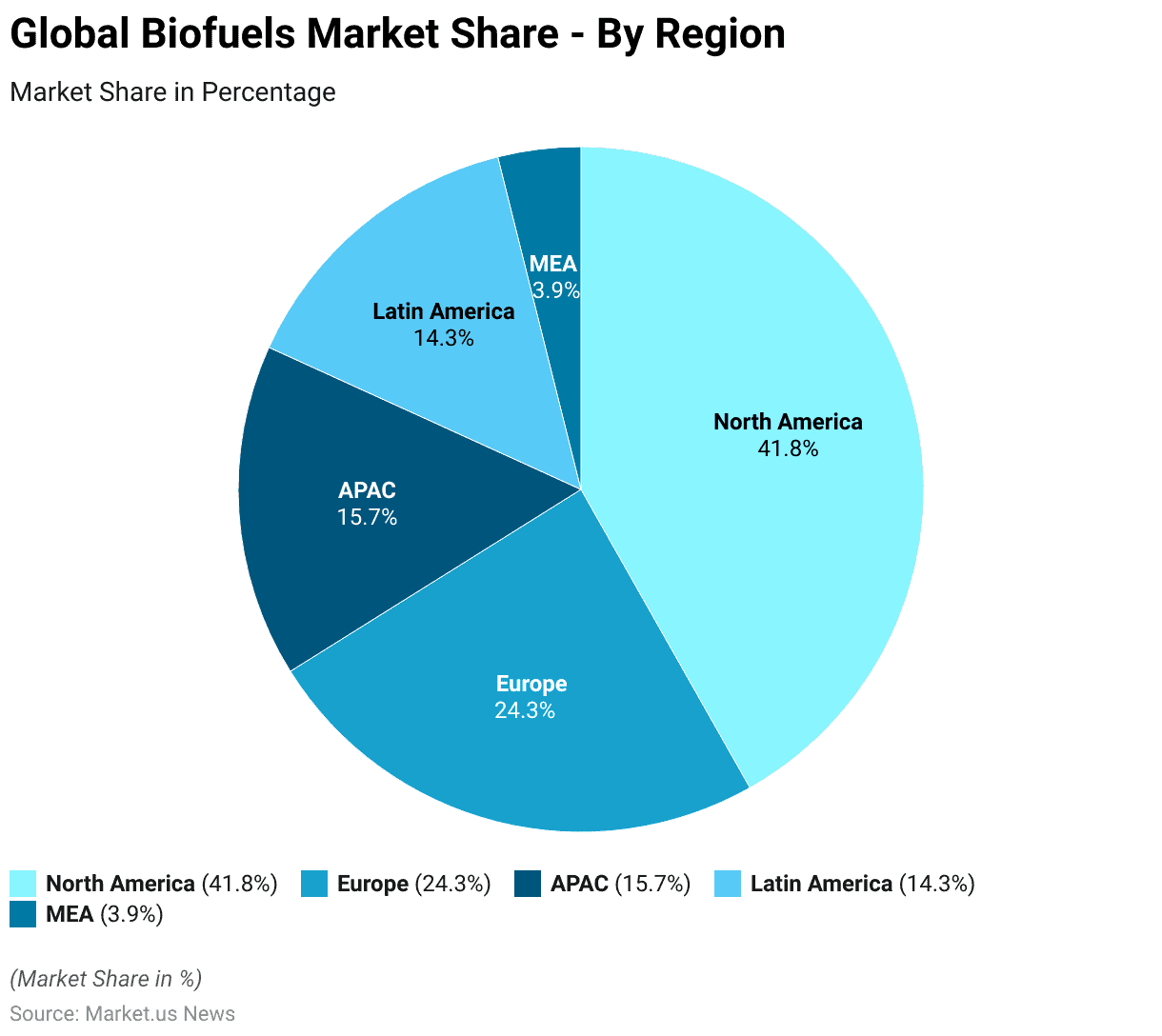
Biofuels Production Market Overview
Global Biofuels Production Market Size
- The market value of biofuel production worldwide has demonstrated a consistent upward trajectory from 2021 to 2030.
- In 2021, the market was valued at USD 110.12 billion.
- By 2030, the market value is projected to reach USD 176.5 billion. Reflecting a robust and sustained growth pattern over the decade.
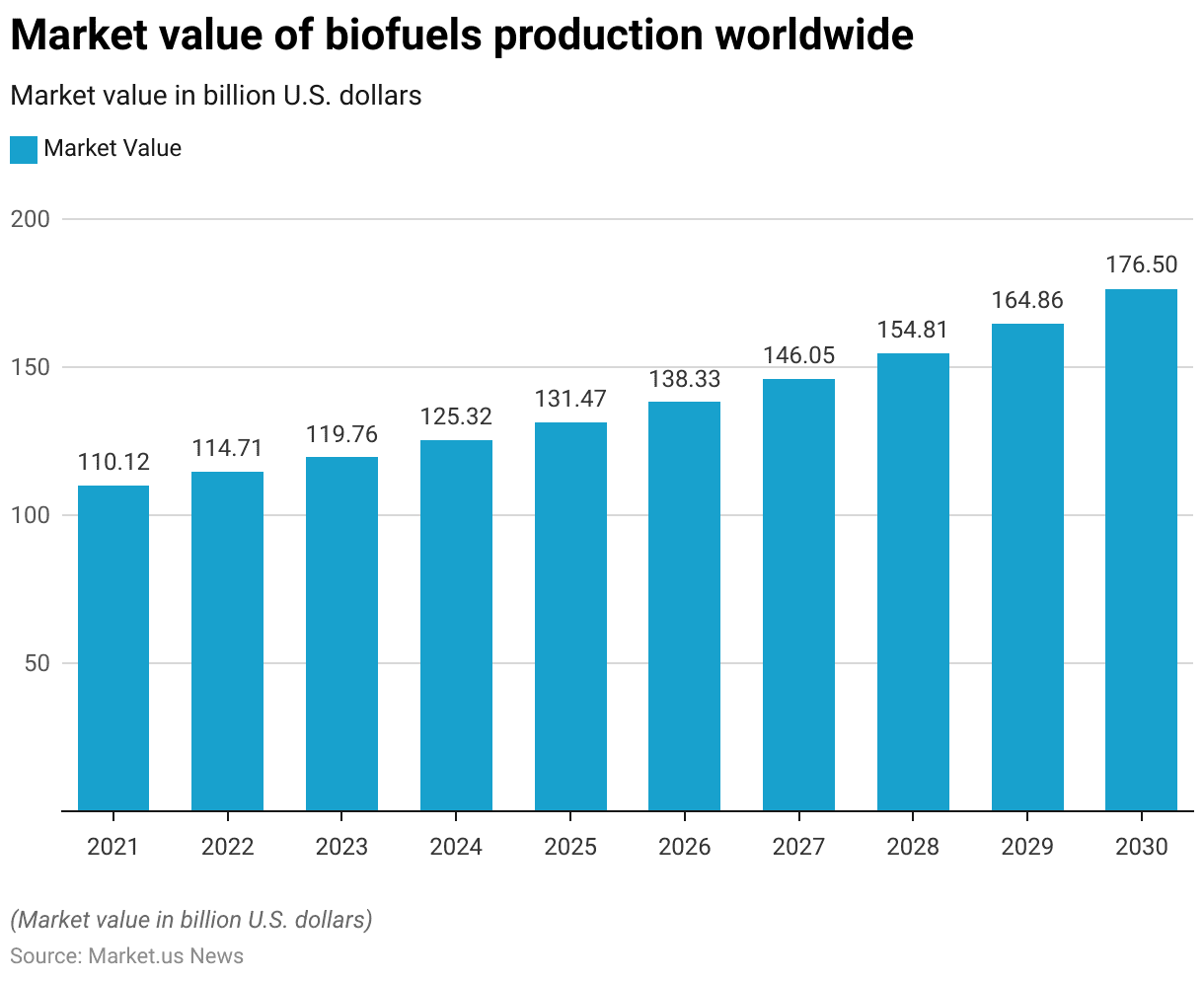
Biofuels Production Market Value- By Fuel Type
- The global production biofuels market, segmented by fuel type, has experienced notable growth from 2021 to 2030.
- In 2021, the market value for ethanol was USD 73.91 billion, followed by biodiesel at USD 23.26 billion, renewable diesel at USD 6.07 billion, biojet fuel at USD 4.2 billion, and other biofuels at USD 2.69 billion.
- By 2030, the market values peaked at USD 112.27 billion for ethanol, USD 38.92 billion for biodiesel, USD 12.25 billion for renewable diesel, USD 7.87 billion for biojet fuel, and USD 5.18 billion for other biofuels.

Global Biofuels Production Market Value – By Form
- From 2021 to 2023, the global biofuel production market has shown steady growth across different forms of biofuels. With solid, liquid, and gaseous fuels all experiencing increases in market value.
- In 2021, the market values were USD 23.26 billion for solid fuels, USD 39.52 billion for liquid fuels, and USD 47.34 billion for gaseous fuels.
- By 2030, the market is expected to achieve values of USD 33.59 billion for solid fuels, USD 63.6 billion for liquid fuels, and USD 79.31 billion for gaseous fuels. Highlighting the robust and sustained growth of the global biofuels market.
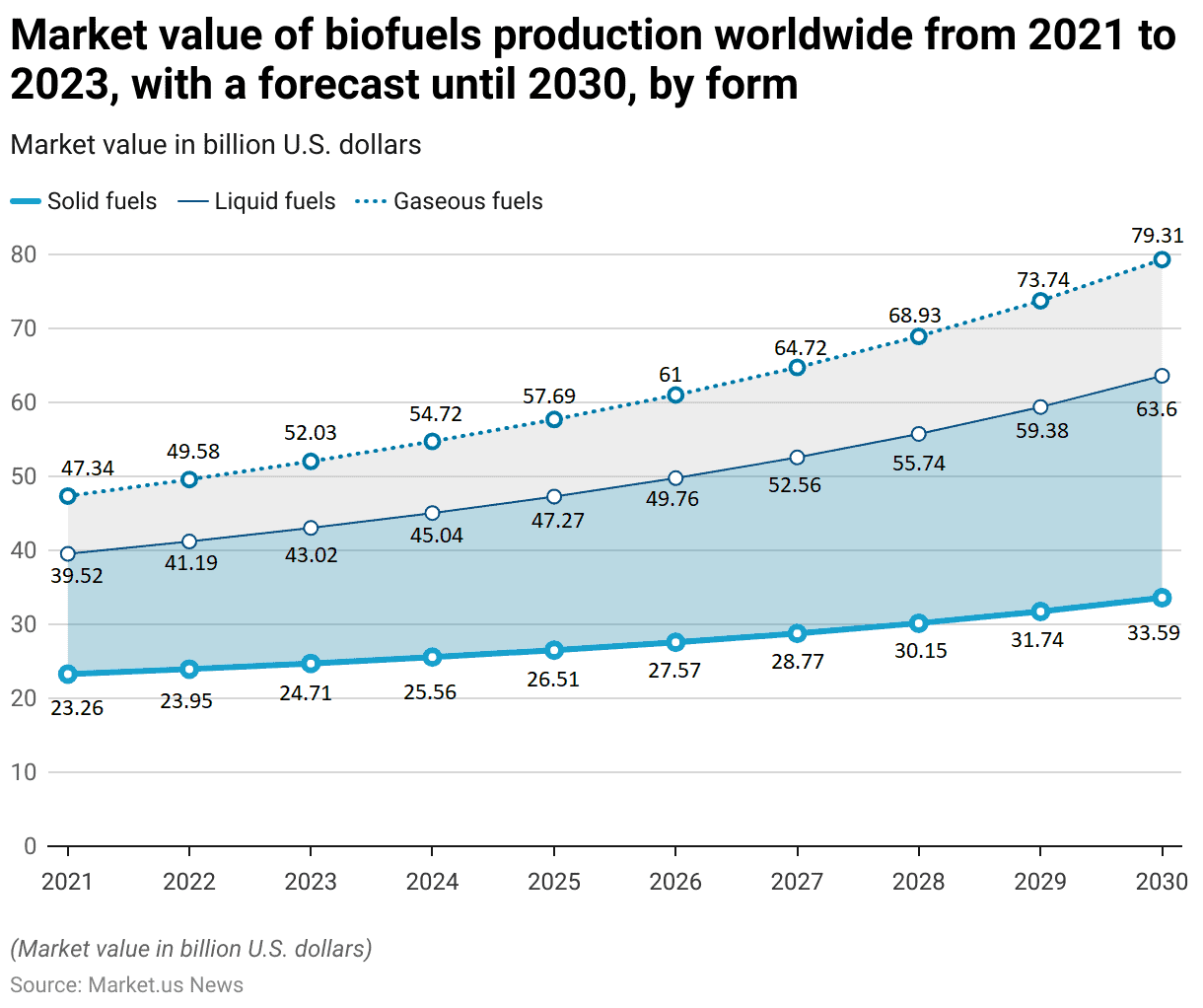
Biofuels Production Market Value – By Region
- In 2023, the global biofuels production market exhibited significant regional variations in market value, with North America leading at USD 44.76 billion. This region is projected to grow to USD 61.57 billion by 2030.
- Europe, with a market value of USD 17.77 billion in 2023, is expected to increase to USD 25.08 billion by the end of the decade.
- The Asia-Pacific (APAC) region, is a major player in the biofuels market. It had a market value of USD 25.42 billion in 2023, which is forecasted to reach USD 42.57 billion by 2030.
- Latin America also demonstrated substantial market activity, with a value of USD 27.81 billion in 2023, projected to grow to USD 41.28 billion by 2030.
- The Middle East and Africa (MEA) region, although smaller in comparison. It had a market value of USD 4 billion in 2023 and is anticipated to increase to USD 6.01 billion by 2030.
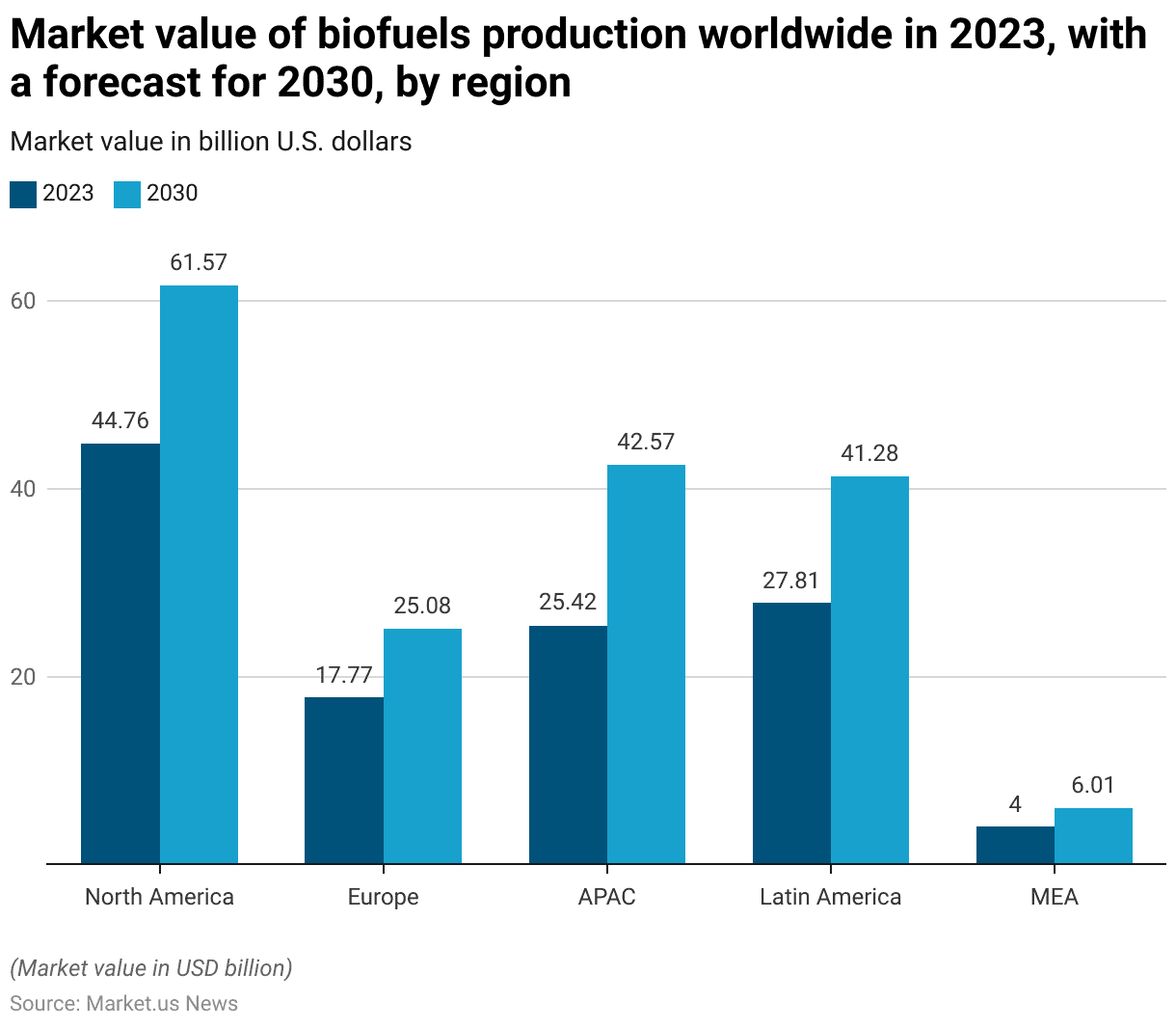
Biofuel Production Statistics
Global Biofuel Production
- Global biofuel production has shown varying trends across different types of biofuels from 2019 to the average projected values for 2023-2025.
- In 2019, ethanol production was at 115 billion liters. While biodiesel and hydrotreated vegetable oil (HVO) were at 41 billion liters and 7 billion liters, respectively.
- The average projected production for the period 2023-2025 indicates further growth. With ethanol expected to reach 119 billion liters, biodiesel 46 billion liters, and HVO significantly increasing to 17 billion liters.
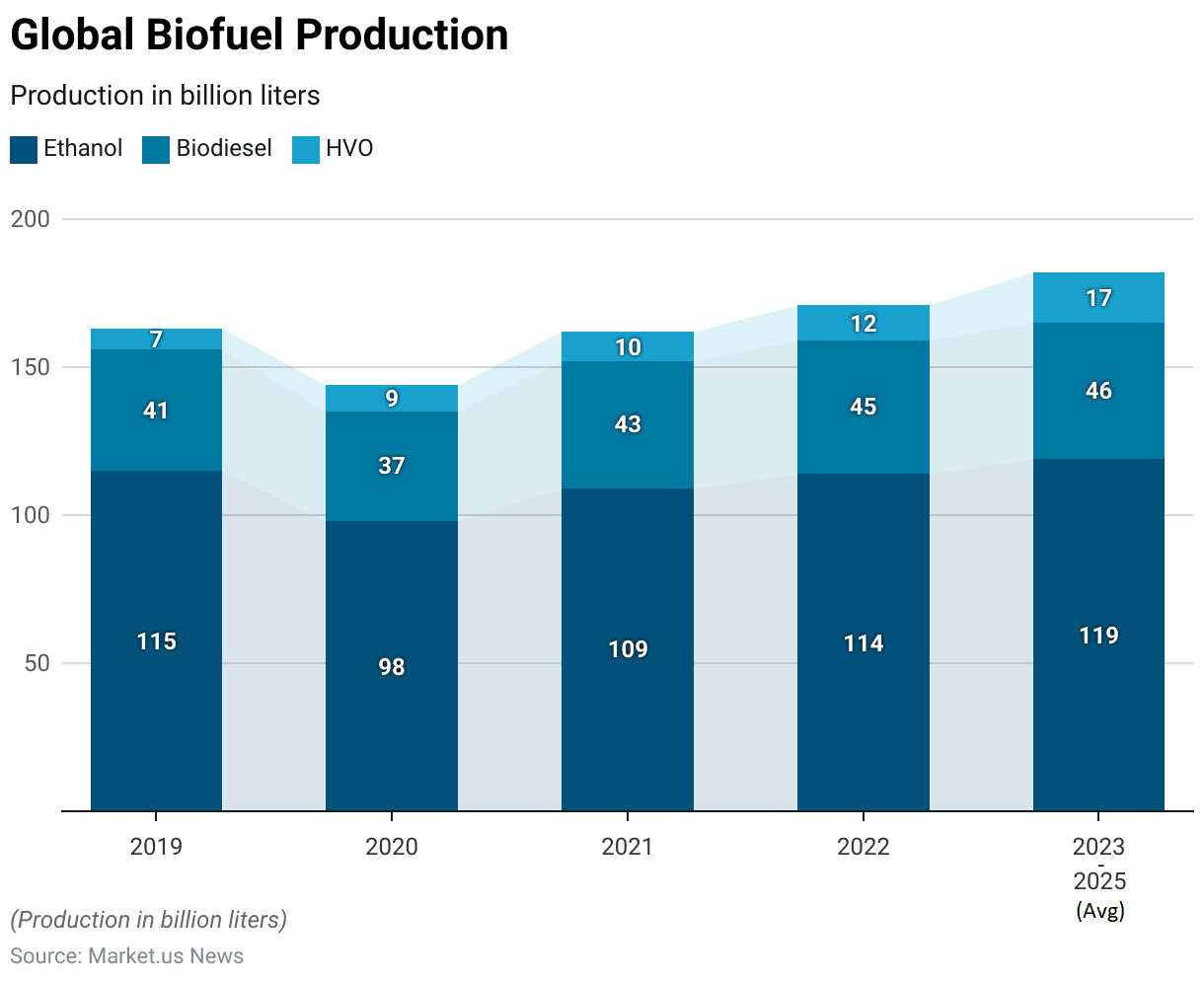
Leading Countries Based On Biofuel Production
- In 2022, global biofuel production was led by the United States. Which produced 1,626.6 petajoules of biofuels, making it the top producer worldwide.
- Brazil followed with a significant contribution of 914.5 petajoules.
- Indonesia ranked third, producing 389.6 petajoules, while China and Germany produced 148.4 petajoules and 137.7 petajoules, respectively.
- Argentina contributed 99.4 petajoules to the global biofuel output, with India close behind at 96.9 petajoules.
- The Netherlands produced 86.8 petajoules, followed by Thailand with 80.6 petajoules, and France rounded out the list with 78.1 petajoules.
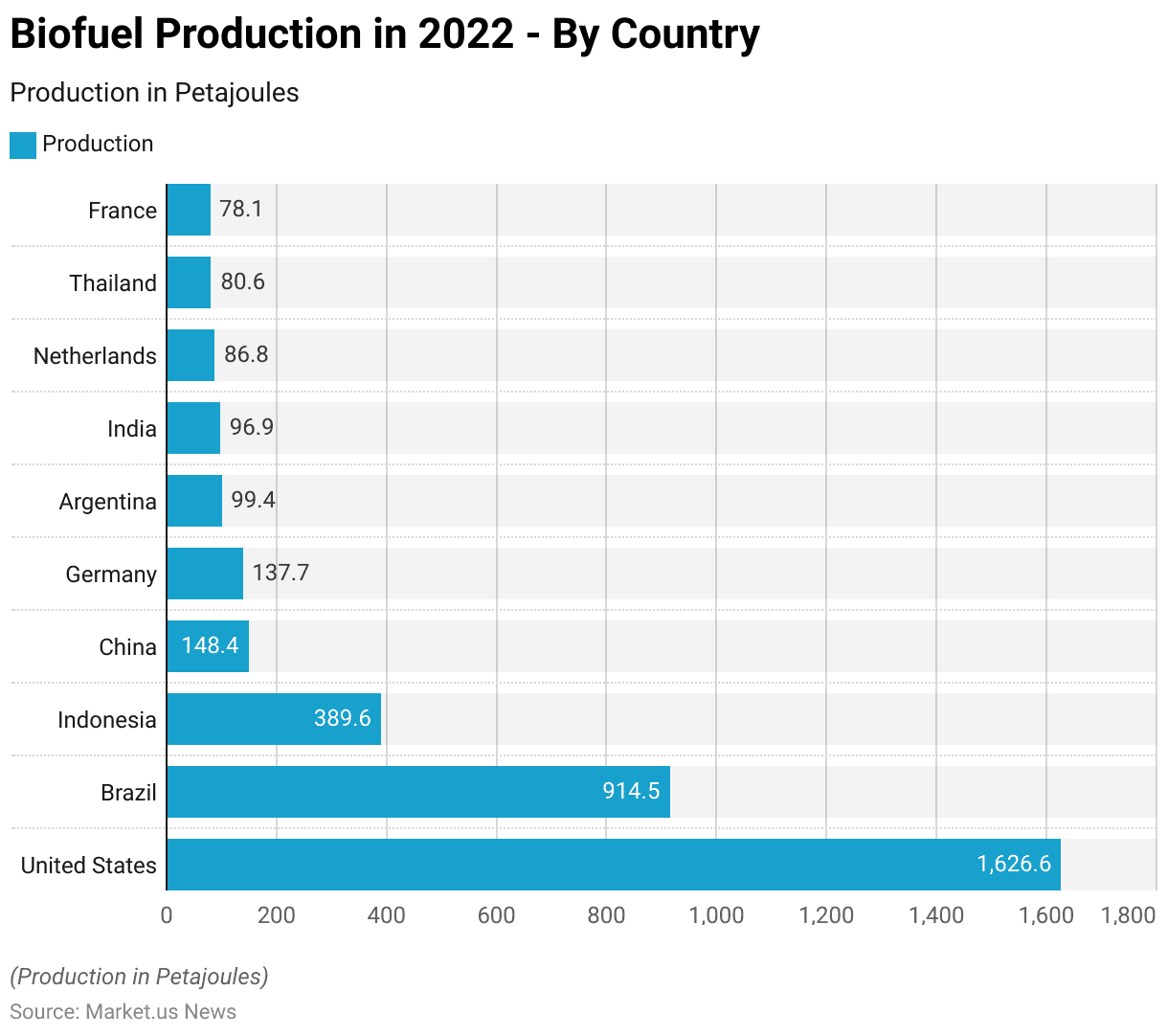
Biofuel Consumption Statistics
Global Biofuel Consumption
- Global biofuel consumption has shown a generally upward trend from 2018 to 2030.
- In 2018, biofuel consumption was recorded at 170.56 billion liters.
- The year 2020 saw a slight dip to 170.7 billion liters, likely due to the impacts of the global pandemic.
- However, by 2021, consumption had rebounded to 179.18 billion liters.
- The trend is expected to persist, with consumption reaching 208.22 billion liters in 2028, 210.7 billion liters in 2029, and 213.7 billion liters by 2030.
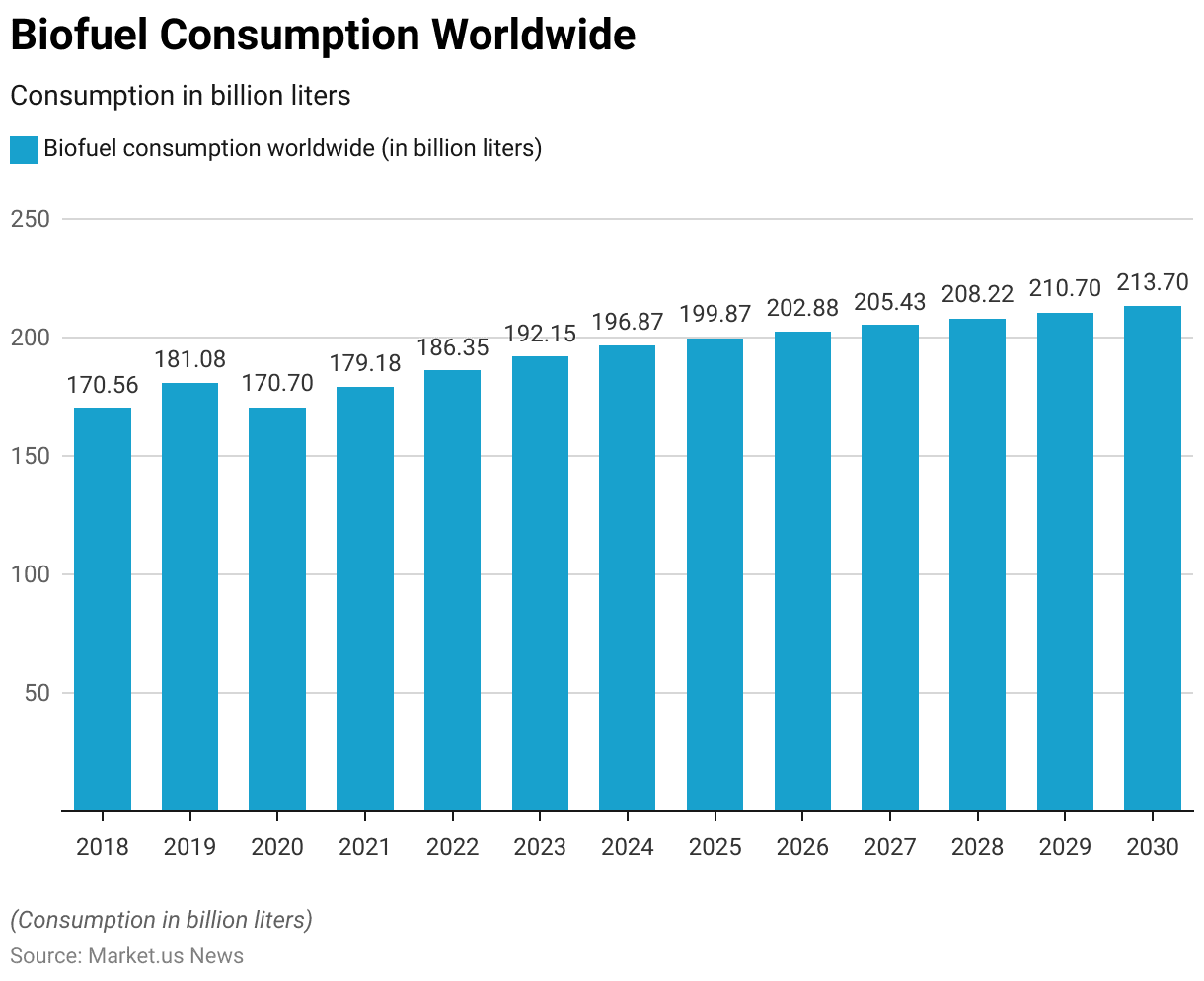
Projected Biofuel Consumption Worldwide- By Country/Region
- The projected biofuel consumption for various countries and regions highlights significant contributions from key players in the global market.
- The United States is expected to lead with a substantial consumption of 71.19 billion liters.
- Brazil follows with a projected consumption of 46.33 billion liters, underscoring its significant role in the biofuel sector.
- The European Union is anticipated to consume 27.06 billion liters, reflecting its ongoing commitment to renewable energy.
- India and China are projected to consume 13.38 billion liters and 12.01 billion liters. Respectively, this indicates their growing focus on sustainable energy sources.
- Indonesia is also expected to contribute significantly, with a projected consumption of 11.93 billion liters.
- Collectively, these countries and regions form a considerable portion of the global biofuel consumption, which is projected to reach 213.1 billion liters.
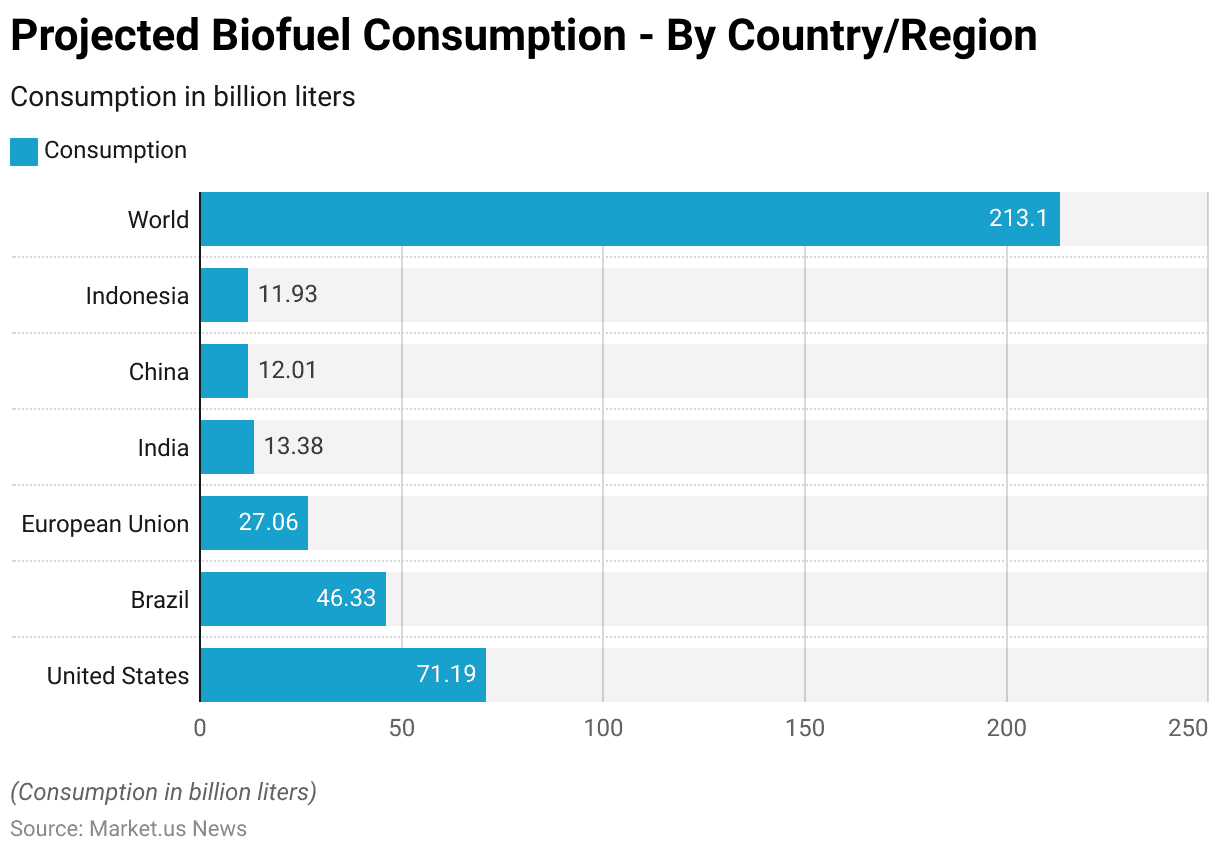
Biofuel Demand Statistics
Global Biofuel Demand
- Global biofuel demand has demonstrated a consistent increase across various fuel types from 2022 to 2028.
- In 2022, the demand for ethanol was 105.7 billion liters, biodiesel was 45.1 billion liters, renewable diesel was 13.3 billion liters, and biojet fuel was 0.2 billion liters.
- The growth trend is expected to persist, with 2028 projected to see ethanol demand at 117.5 billion liters, biodiesel at 52.9 billion liters, renewable diesel at 26.4 billion liters, and biojet fuel at 5.2 billion liters.
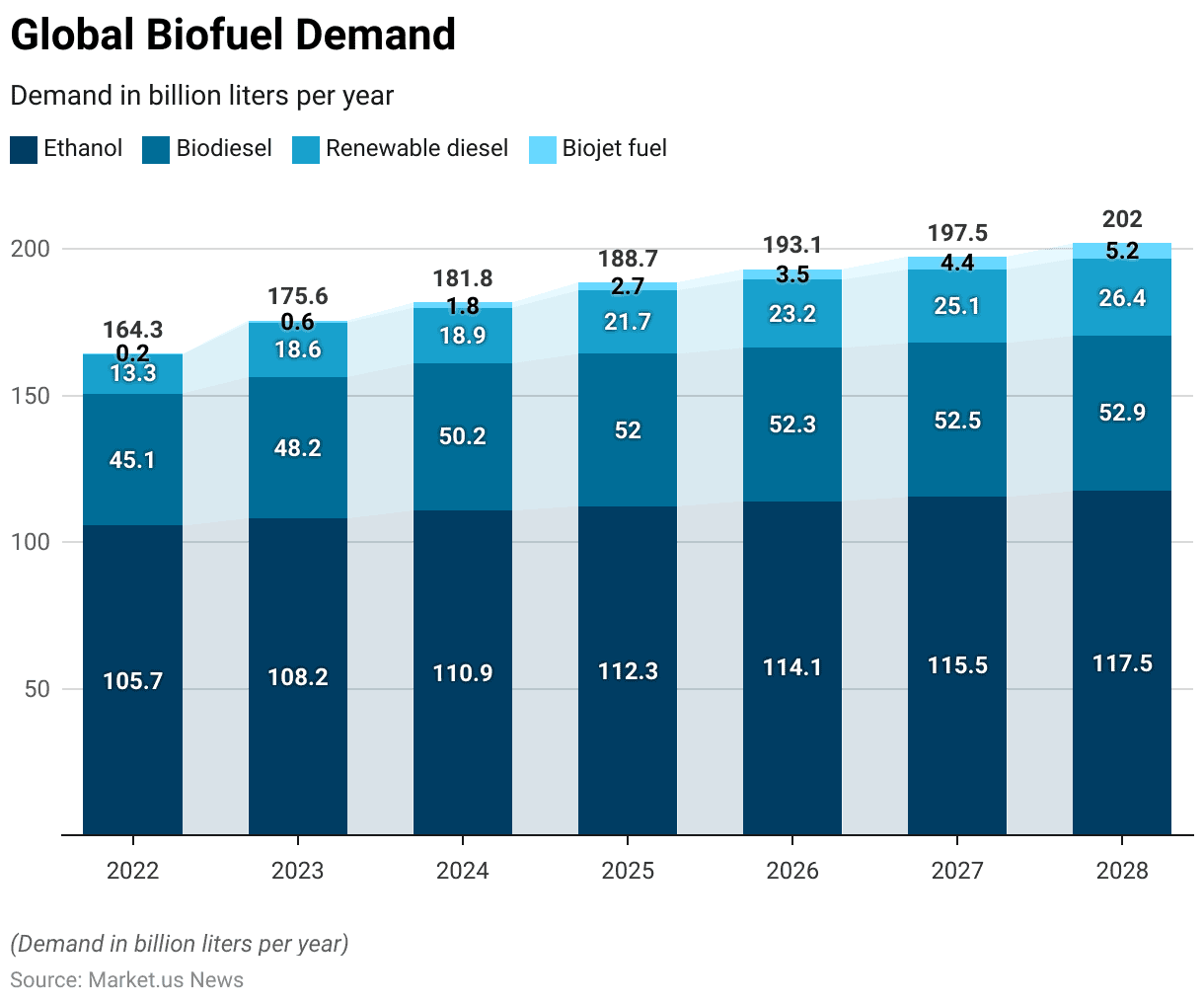
Biofuel Energy Production Statistics
Biofuel Energy Production – By Country
- In terms of biofuel energy production, the United States leads globally with an impressive output of 451.83 terawatt-hours (TWh) per year.
- Brazil follows as the second-largest producer, with 254.02 TWh per year, highlighting its significant contribution to the global biofuel market.
- Indonesia ranks third with a production of 108.22 TWh per year, while China and Germany produce 41.22 TWh and 38.26 TWh per year, respectively.
- Argentina and India also contribute notably, with 27.61 TWh and 26.92 TWh per year, respectively.
- The Netherlands produces 24.11 TWh per year, closely followed by Thailand at 22.4 TWh and France at 21.68 TWh per year.
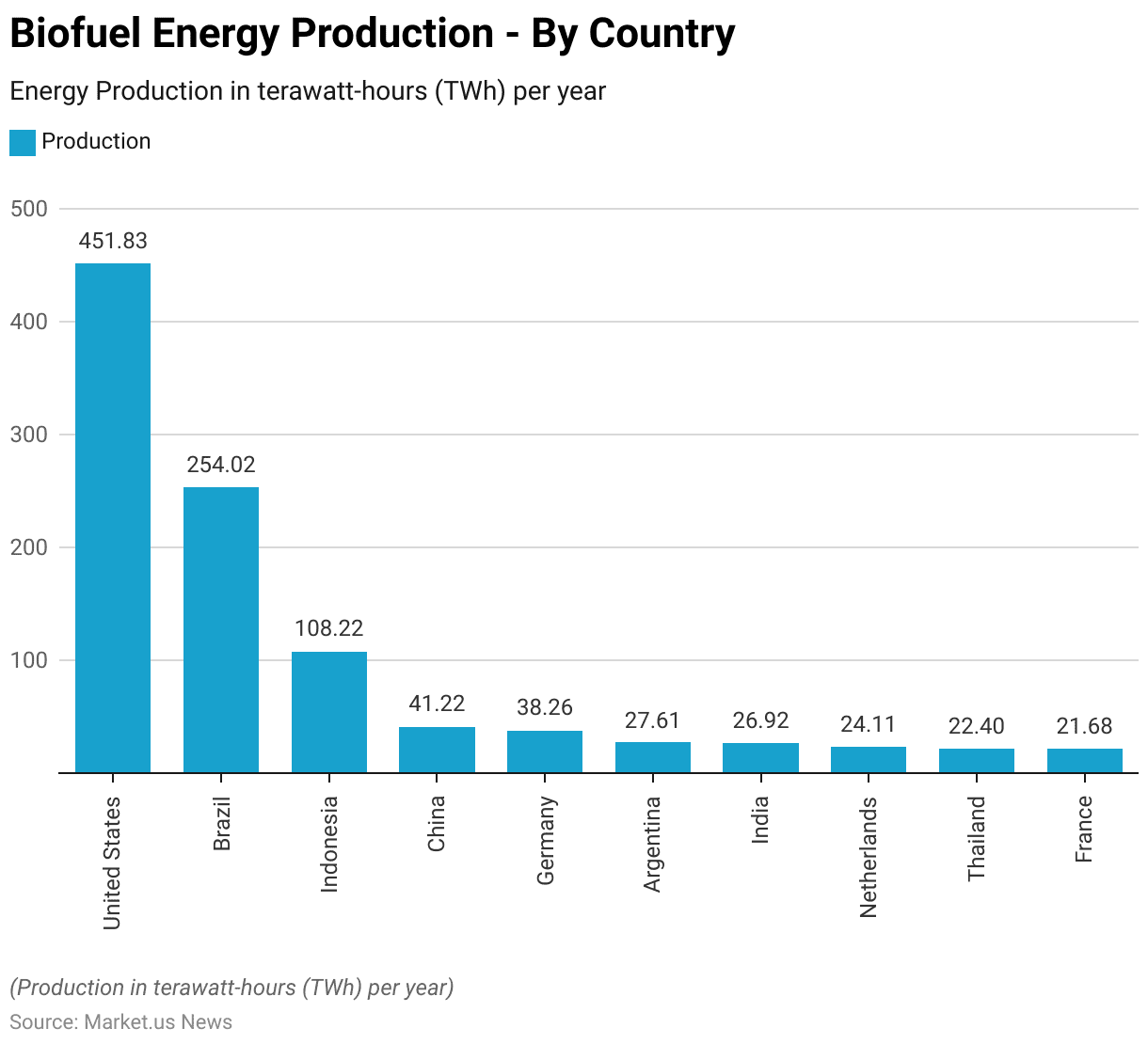
Potential Benefits of Biofuels
- Ethanol from sugarcane is highly efficient due to high yields per hectare.
- Utilizing bagasse for power and heat during production reduces fossil energy input and can lower CO2 emissions to 0.2-0.3 kg CO2 per liter of ethanol, compared to 2.8 kg CO2 per liter for gasoline.
- Ethanol from corn and cereals can reduce CO2 emissions by 15%-25% compared to gasoline.
- Lignocellulosic ethanol shows a greater reduction, cutting CO2 emissions by 40%-60% compared to fossil fuels like diesel.
Potential Side-effects of Biofuels
- In 2020, the Midwest, renowned for its robust agricultural output, recorded a notable greenhouse gas footprint. The agriculture sector emitted 315 million tons of CO2 equivalent (MtCO2e) and sequestered 38 MtCO2e, resulting in net emissions of 278 MtCO2e.
- This constitutes approximately 20% of the region’s total emissions, while nationally, agriculture contributes around 10% of emissions. Emissions originate from fertilizer use, manure management, on-farm energy consumption, and land use alterations.
- Corn and soybeans, occupying 75% of the Midwest’s arable land, play a pivotal role in these emissions, largely due to their extensive use in biofuel production. Consequently, the biofuels industry significantly influences the region’s agricultural emissions.
Regulations, Laws, And Policies for Biofuels
- Biofuel regulations, laws, and policies vary significantly across countries, reflecting diverse approaches to promoting renewable energy.
- In the United States, the Renewable Fuel Standard (RFS) sets specific biofuel volume requirements, aiming to reduce dependence on foreign oil and support domestic production of low-carbon fuels.
- For 2023-2025, the U.S. Environmental Protection Agency (EPA) has established targets for various biofuels, including cellulosic biofuel and biomass-based diesel.
- The European Union, under the revised Renewable Energy Directive (RED II), emphasizes sustainability criteria and aims to limit the negative impacts of biofuel production, such as indirect land use change (ILUC).
Discuss Your Needs With Our Analyst
Please share your requirements with more details so our analyst can check if they can solve your problem(s)





